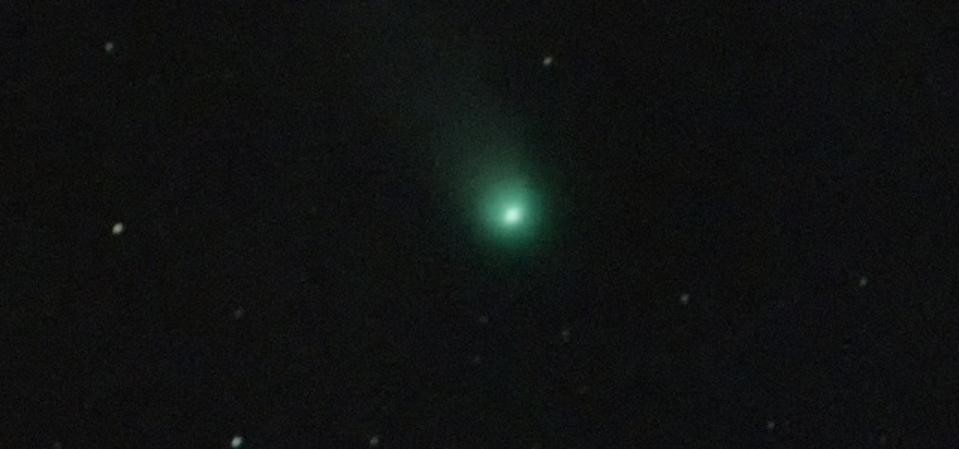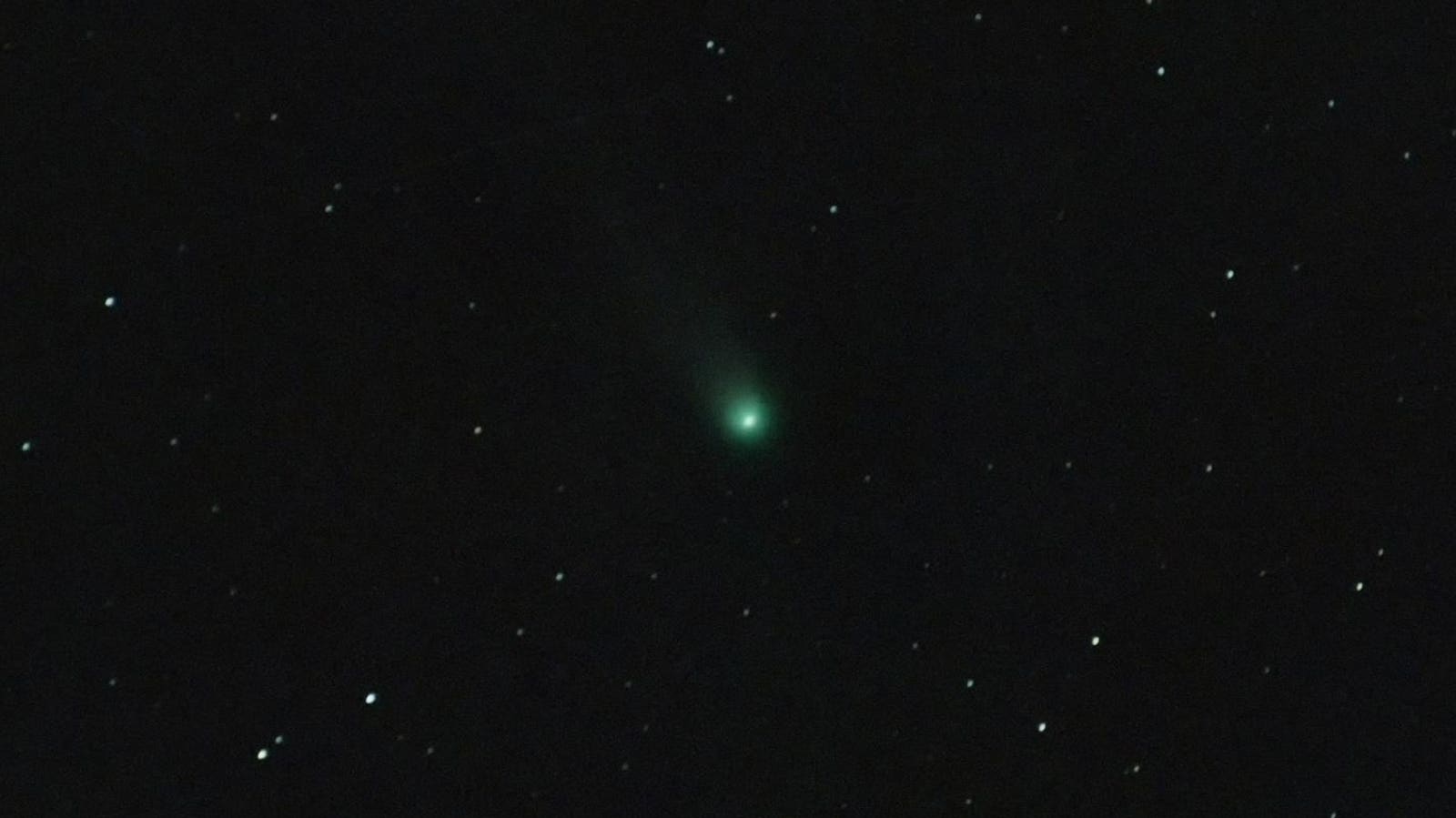
Comet C/2025 A6 (Lemmon) appears in the sky above Molfetta, Italy, on October 11, 2025, around 6:00 AM to the right of the Big Dipper, before dawn. Comet C/2025 A6 (Lemmon), discovered at the beginning of the year, experiences an unexpected and sudden increase in brightness during the summer, quickly becoming one of the most interesting celestial objects of 2025. (Photo by Davide Pischettola/NurPhoto via Getty Images)
NurPhoto via Getty Images
A comet will be visible in binoculars this week, close to the Big Dipper, from the Northern Hemisphere as it makes its once-in-1,350-year journey around the sun.
First discovered on Jan. 3, 2025, by the Mount Lemmon Survey near Tucson, Arizona, Comet Lemmon — also called comet A6 and C/2025 A6 (Lemmon) — will, by Tuesday, Oct. 21, get to within 55.4 million miles (89.2 million kilometers) of Earth, the closest it will get, just as the Orionid meteor shower peaks.
ForbesComet Tracker For Sunday: When And Where To See Comets Lemmon And SWANBy Jamie CarterWhat Is Comet Lemmon?
It’s a large, long-period comet from the Oort Cloud, a sphere of millions of comets wrapped around the solar system. It has a bluish tail about twice the apparent diameter of the moon and a thin, straight appearance pointing directly away from the sun, according to Space.com. In binoculars, it will look like a diffuse, fuzzy patch.
How Bright Is Comet Lemmon?
It’s then it will likely be brightest, but according to the Comet Observation Database, it’s already reached magnitude +5.2, which is just within human vision. You’ll need an exceptionally dark sky site to pick it out with the naked eye this week, below the Big Dipper, but with a pair of binoculars and good timing, it should be visible after sunset.
How Far Away Is Comet Lemmon?
Between Sunday, Oct. 12 and Saturday, Oct. 18, Comet Lemmon will travel from 66 million miles (106 million kilometers) from Earth to 56 million miles (91 million kilometers) as it gets closer to Earth, likely brightening as it does.
The path of Comet Lemmon (C/2025 A6) from Oct. 12-19, 2025.
In-The-Sky.com (used with permission)When And Where To See Comet Lemmon
Comet Lemmon is currently positioned in the northwest just before sunrise and in the northeast just after sunset. To see it, find out the exact time of sunrise and sunset where you are. The best time to see it is a 30-minute window starting about 90 minutes after sunset. If you’re an early riser, another great time to see it is during a 30-minute window beginning about 90 minutes before sunrise (or earlier).
ForbesMonday’s Comet Tracker: How To See Two Comets Close To Bright StarsBy Jamie Carter
That’s possible because Comet Lemmon will be in the constellation Ursa Major, “the Great Bear,” home to the Big Dipper, which is a circumpolar constellation — meaning it appears to travel around the North Star, Polaris. Earth’s northern axis points at Polaris, meaning Ursa Major is always in the night sky (though at this time of year it’s very low on the horizon). You’ll need somewhere you can see low to the northern horizon.
A good night to watch might be Thursday, Oct. 16, when it will pass within a degree of the bright star Cor Caroli in the constellation Canes Venatici — but still close to the Big Dipper.
Where to find Comet Lemmon after sunset on Oct. 126, 2026 — close to the star Cor Caroli, beneath the Big Dipper’s handle.
StellariumWhat About Comet SWAN?
Only discovered on Sept. 11, 2025, as it exited from the sun’s glare, Comet SWAN — also called comet R2 and C/2025 R2 (SWAN) — is much dimmer, at magnitude 5.9, in the constellation Ophiuchus. Although it will be significantly harder to find, you may as well try since the viewing window is the same as for Comet Lemmon, for about 30 minutes, about 90 minutes after sunset, but this time in the southwestern night sky. It’s above the bright star Antares in the constellation Scorpius.
A handy way of finding the location of the comets in your sky without having to be an expert is to use the finder charts at In-The-Sky.com or stargazing apps such as Sky Guide, Stellarium and SkySafari.
The changing position of Comet SWAN C/2025 R2 during October 2025.
StellariumBest Time To See Comet Lemmon And Swan
Observing the comets now is essentially an insurance policy. They are not at their brightest, so it requires more patience, but waiting until they are brightest could be problematic. Not only could clouds block your view, but one or both comets could disintegrate and/or suddenly become much fainter. The best viewing for both comets is set to be the evening of Oct. 20 — their closest approach to Earth — which just happens to coincide with both a new moon ( meaning very dark, moonless night skies) and the peak of the annual Orionid meteor shower.
Check my feed every day this month for a daily “comet tracker” with finder charts and tips for viewing Comet Lemmon from mid-northern latitudes.
ForbesComet Lemmon: Your Ultimate Viewing Guide To The ‘Comet Of The Year’By Jamie CarterForbesSee Rare Sight Of Two Comets As Meteor Shower Peaks — Here’s WhenBy Jamie CarterForbesSee Two Comets Share October Night Sky With Fireball SwarmBy Jamie Carter

